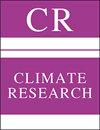加勒比海南部地形通道式海洋-大气耦合和夏季气候多变性
IF 1.6
4区 地球科学
Q4 ENVIRONMENTAL SCIENCES
引用次数: 0
摘要
摘要:这项研究将全球气候与地区天气联系起来,在太平洋-大西洋盆地大尺度沃克环流的背景下考虑加勒比信风的强度,以及涉及淡水通量、海洋混合层深度和哥伦比亚以北气流地形渠化之间的海气相互作用的局部过程。安第斯山脉增强了加勒比海南部信风驱动的沿岸上升流,并形成了夏季气候多变性的焦点。对 1979-2022 年间 6-7 月地表带状风的经验正交函数(EOF)分析显示了这一点。哥伦比亚西北部北纬 12°、西经 75°处的 EOF 负荷最高。点到场与 EOF 时间分数的相关性反映了与厄尔尼诺-南方涛动(ENSO)有关的太平洋-大西洋热偶极和沃克环流。随着加勒比海南部信风减弱,径流增加,上层海洋浮力增强,西向洋流减弱。综合差异显示,6-7 月缓慢的信风条件会诱发一股逆流,将温暖的淡水从哥伦比亚向东北方向扩散。这股逆流向安的列斯群岛扩散,具有足够的记忆力,使 8-9 月间热带气旋的数量增加了两倍。2011 年 6 月的缓慢贸易风案例研究强调了关键的海气相互作用。安第斯山脉以北的大尺度气流通道为厄尔尼诺/南方涛动信号的传播创造了一个狭窄的大气桥梁。本文章由计算机程序翻译,如有差异,请以英文原文为准。
Topographically channeled ocean-atmosphere coupling in the southern Caribbean and summer climate variability
ABSTRACT: This research links global climate to regional weather by considering Caribbean trade wind strength in the context of the large-scale Walker circulation across the Pacific-Atlantic basins, and localized processes involving air-sea interactions between freshwater flux, the ocean mixed-layer depth, and topographic channeling of airflow north of Colombia. Trade wind driven coastal upwelling in the southern Caribbean is enhanced by the Andes Mountains, and creates a focal point for summer climate variability. This emerges in empirical orthogonal function (EOF) analysis of June-July surface zonal winds in the period 1979-2022. Highest EOF loading occurs at 12° N, 75° W northwest of Colombia. Point-to-field correlations with the EOF time score reflect a Pacific-Atlantic thermal dipole and Walker circulation linked with the El Niño-Southern Oscillation (ENSO). As southern Caribbean trade winds weaken, run-off increases, the upper ocean becomes buoyant, and westward currents slacken. Composite differences show that slow trade-wind conditions in June-July induce a counter-current that spreads warm fresh water northeastward from Colombia. This plume disperses toward the Antilles Islands with sufficient memory to triple the number of tropical cyclones in August-September. A slow trade-wind case study in June 2011 emphasizes key air-sea interactions. Channeling of the large-scale airflow north of the Andes Mountains creates a narrow atmospheric bridge for transmission of ENSO signals.
求助全文
通过发布文献求助,成功后即可免费获取论文全文。
去求助
来源期刊

Climate Research
地学-环境科学
CiteScore
2.90
自引率
9.10%
发文量
25
审稿时长
3 months
期刊介绍:
Basic and applied research devoted to all aspects of climate – past, present and future. Investigation of the reciprocal influences between climate and organisms (including climate effects on individuals, populations, ecological communities and entire ecosystems), as well as between climate and human societies. CR invites high-quality Research Articles, Reviews, Notes and Comments/Reply Comments (see Clim Res 20:187), CR SPECIALS and Opinion Pieces. For details see the Guidelines for Authors. Papers may be concerned with:
-Interactions of climate with organisms, populations, ecosystems, and human societies
-Short- and long-term changes in climatic elements, such as humidity and precipitation, temperature, wind velocity and storms, radiation, carbon dioxide, trace gases, ozone, UV radiation
-Human reactions to climate change; health, morbidity and mortality; clothing and climate; indoor climate management
-Climate effects on biotic diversity. Paleoecology, species abundance and extinction, natural resources and water levels
-Historical case studies, including paleoecology and paleoclimatology
-Analysis of extreme climatic events, their physicochemical properties and their time–space dynamics. Climatic hazards
-Land-surface climatology. Soil degradation, deforestation, desertification
-Assessment and implementation of adaptations and response options
-Applications of climate models and modelled future climate scenarios. Methodology in model development and application
 求助内容:
求助内容: 应助结果提醒方式:
应助结果提醒方式:


